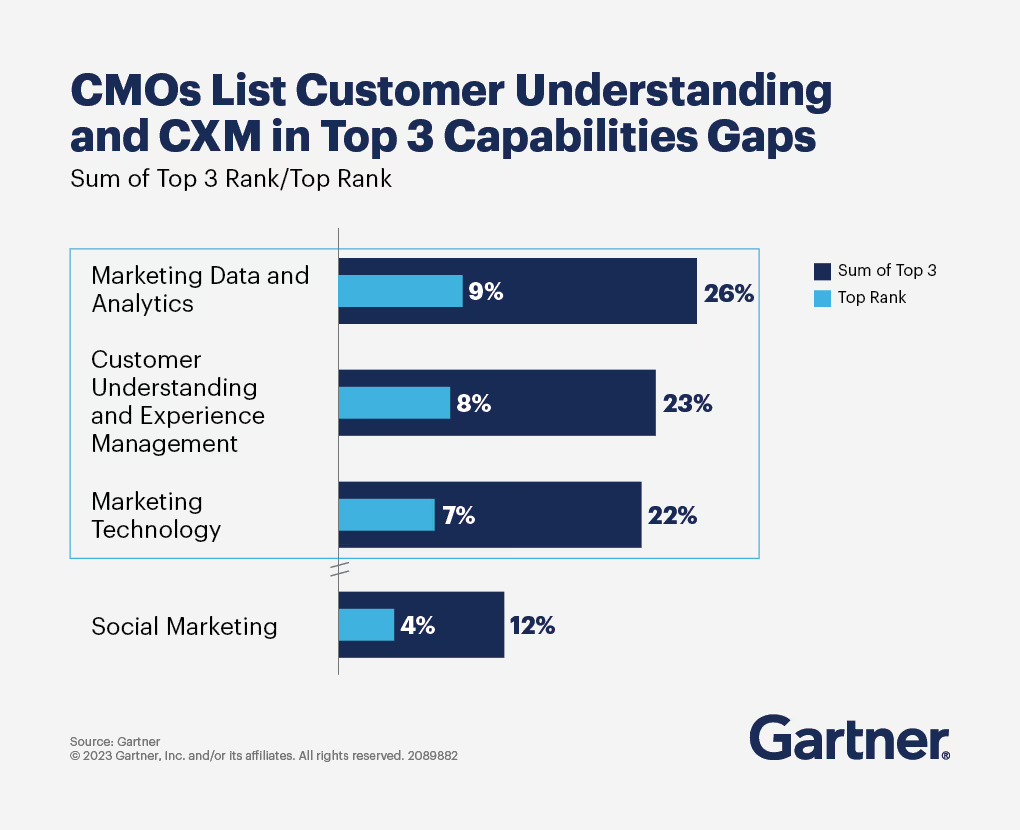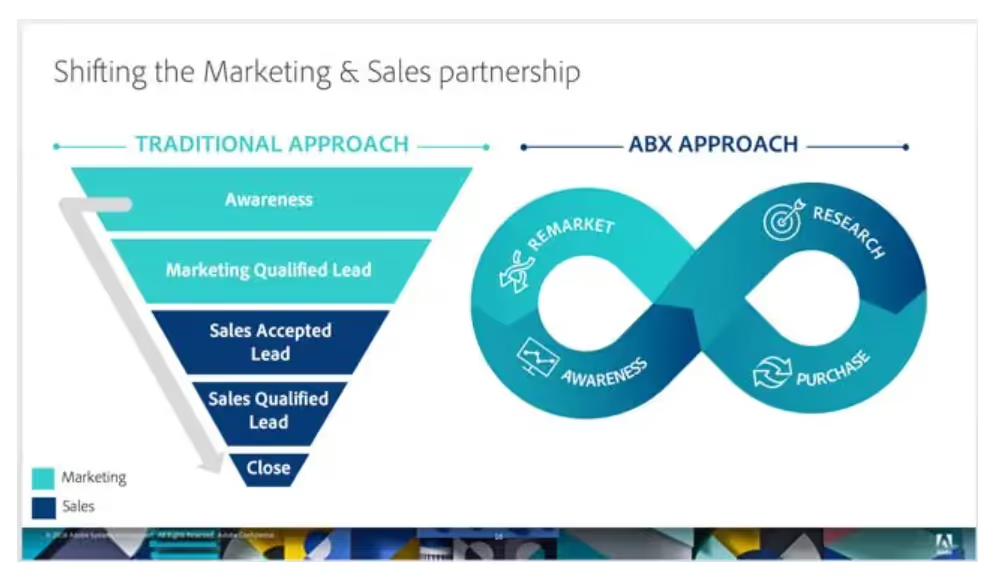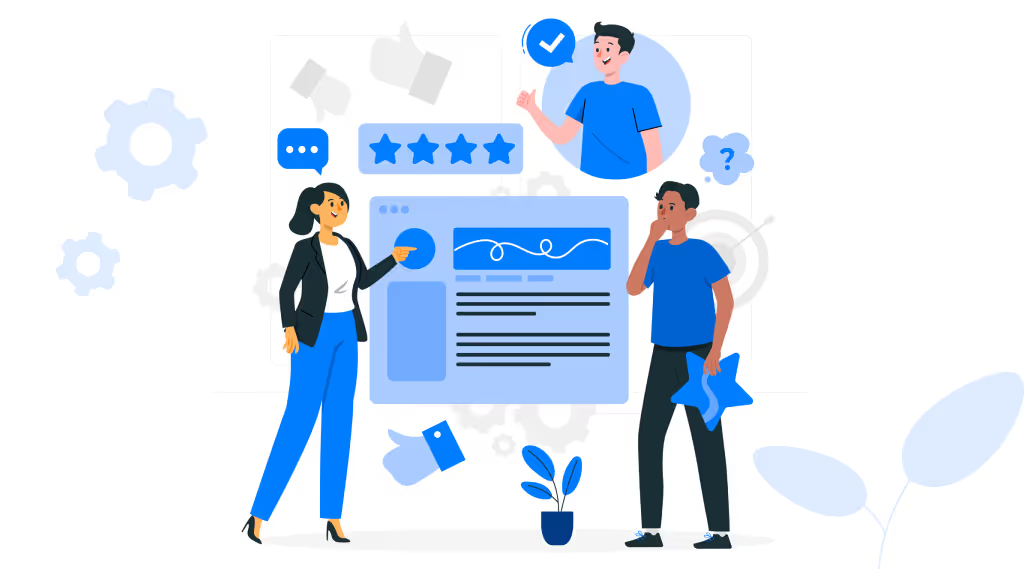Introduction
Let me share a real story I read. A marketer shared that their company spent $10,000+ to acquire a Fortune 500 client, only making back $2,500 on the first engagement. By the time the client committed long-term, they'd spent over $30,000—but when they did commit, they generated $150K+ annually for a decade. That's ABM's power: high cost, high reward.But here's where it gets interesting. A new conversation is emerging: Is ABX (Account-Based Experience) a better approach? Some are calling it the next evolution of ABM, making customer experience the priority instead of just marketing and sales alignment.So, in this blog, let's dive in and explore what's really happening in the world of account-based strategies. Know what is ABX, what exactly makes ABX different from ABM and, more importantly, should B2B SaaS companies shift their strategy?

What is ABX?
Account-Based Experience (ABX) is a go-to-market strategy that combines the targeting precision of ABM and the engagement power of inbound marketing, all while maintaining primary focus on delivering exceptional customer experience. Unlike traditional approaches focused on individual leads, ABX recognizes that B2B buying decisions involve multiple stakeholders, typically 6 to 10, and orchestrates relevant, trusted interactions across the entire customer journey. ABX acknowledges the complexity of marketing not only to leads, but to entire buying committees. The targeting strategies are curated accordingly.

The Shift Towards Account-Based Experience
Remember when ABM changed the marketing game? It broke us free from mass marketing and helped us focus on high-value accounts. But here's what many of us learned the hard way: winning an account isn't the finish line—it's just the beginning.A SaaS CMO recently told me something that really resonated: they were great at winning big accounts, but struggled to expand them. They had all the right tools to get clients on board, but post-sale, it felt like they were neglecting those very accounts.This is where ABX comes in. It takes ABM beyond lead generation and conversion, focusing on delivering a cohesive, customer-first experience across every touchpoint. Instead of viewing the account as a pipeline metric, ABX sees it as a relationship that must be nurtured from the first interaction to expansion and retention.
The Information Abundance Challenge
Today, buyers are overwhelmed with content. They're bombarded with blogs, ebooks, webinars, product reviews, videos, and endless email sequences. The result? A classic "tragedy of the commons" where everyone's attempt to capture attention creates a terrible customer experience that benefits no one.Modern B2B buyers:
- Spend only 17% of their buying process meeting with potential vendors
- Conduct most of their research anonymously on third-party websites
- Actively avoid forms and sales contact until they're ready
- Spend more time consulting with their buying committee than with vendors
Why This Matters Now More Than Ever
Let's look at some compelling statistics:
- 44.5% of organizations worldwide consider customer experience their key competitive differentiator - Statista, 2021
- 45% believe AI will reshape customer experience within five years - Statista, 2021
- 60% of marketing leaders use AI to predict customer behavior and needs - Statista, 2021
- 47% leverage AI to uncover frequent customer journeys, ensuring a seamless CX - Statista, 2022
- The majority of B2B buyers now expect B2C-like personalization
But here's what's really interesting: businesses that invest in creating great experiences grow revenue 40% faster, improve retention by 70%, and increase customer lifetime value 1.6x more than other companies. This isn't just about making customers happy—it's about survival in an increasingly competitive market.Taylor Young, Principal ABM Strategy and Customer Experience at Terminus, talks about how they prioritize a customer-first approach that ensures ABM programs align with real-world needs and deliver value. In her words, “If you don't really understand your customer and have enough empathy to understand exactly your personas and your accounts, and what they need from you, then you're going to start off on the wrong foot. I was previously a customer of Terminus, originally, and a power user at that company... The vision was really to have someone who could come and be an advocate for, like, they lived the life of who the customer is.”
ABX: A Full-Funnel, Customer-Centric Approach
Account-Based Experience (ABX) builds on the foundation of Account-Based Marketing (ABM) but takes a broader, more holistic approach. While ABM primarily focuses on acquiring high-value accounts through personalized marketing and sales efforts, ABX aligns every department—marketing, sales, customer success, product, and even leadership—to create a seamless customer experience across the entire lifecycle.This is how ABX works across departments:
Marketing Generates Intent-Driven Engagement
- ABX refines engagement strategies to focus on accounts showing real buying intent.
- AI-driven insights and predictive analytics help marketing teams craft highly personalized campaigns that resonate with specific pain points of target accounts.
- Content strategies are built around the customer’s journey, ensuring messaging is not just acquisition-focused but also educates customers on long-term value and scalability of the product.
Sales Nurtures and Converts with Deep Personalization
- In ABX, sales doesn’t just close deals—it builds long-term relationships.
- Sales teams work alongside marketing and customer success to align messaging, use customer pain points effectively, and create continuity from pre-sale to post-sale.
- Personalized outreach goes beyond generic sales pitches. Instead, it involves multi-threaded engagement with various stakeholders in an account to ensure widespread buy-in.
- Sales can leverage real-time engagement insights to determine the best timing and approach for follow-ups, making interactions more relevant and impactful.
Customer Success Ensures Long-Term Satisfaction and Retention
- One of the biggest differentiators of ABX is the early integration of customer success teams in the sales process.
- Instead of customer success stepping in only after a deal is closed, they become part of the initial conversations, ensuring a smooth onboarding process and long-term alignment.
- This approach helps proactively address potential roadblocks, mitigate churn risks, and set clear expectations for implementation.
- Regular check-ins, health scores, and proactive engagement ensure customers see value, increasing the likelihood of renewals and upsells.
Product Teams Shape Offerings Based on Customer Needs
- In an ABX model, customer feedback and product adoption insights are fed back to marketing and sales teams.
- This ensures that product roadmaps are aligned with customer needs and marketing efforts accurately communicate the evolving value proposition.
Leadership Aligns Business Goals with Customer Experience
- ABX breaks down silos across departments by ensuring leadership drives customer-centric initiatives across marketing, sales, and customer success.
- Metrics such as Net Revenue Retention (NRR), Customer Lifetime Value (CLV), and expansion revenue become key indicators of ABX success.
For instance, if a company is struggling with high churn rates despite acquiring large accounts, shifting to an ABX approach can help. By integrating customer success teams early in the sales process, businesses can ensure better onboarding and post-sale engagement. This not only improves renewal rates but also opens up opportunities for expansion revenue down the line.

Key Takeaways: How ABX Outperforms ABM Across the Customer Lifecycle
AspectABM (Traditional Approach)ABX (Full-Funnel, Customer-Centric Approach)Focus AreaPrimarily pre-sale, focused on lead acquisition.Full-funnel approach, covering acquisition, onboarding, retention, and expansion.Marketing’s RoleDrives top-of-funnel demand with personalized campaigns.Engages throughout the lifecycle, ensuring long-term customer value.Sales StrategyFocuses on closing deals and passing accounts to customer success.Builds lasting relationships with continuous, data-driven engagement.Customer SuccessEngages post-sale, often as a reactive function.Proactively involved before, during, and after the sale, ensuring smooth onboarding and adoption.Product AlignmentProduct development is often disconnected from marketing and sales feedback.Customer insights fuel product development, ensuring offerings evolve with real user needs.Growth MetricsSuccess measured by new customer acquisition and conversion rates.Success measured by customer retention, lifetime value (CLV), and expansion revenue.
ABX: Personalization Across the Entire Lifecycle
Unlike ABM, ABX ensures personalization doesn’t end at conversion. Instead of viewing the customer as "won" after the sale, ABX treats every stage—pre-sale, onboarding, adoption, retention, and expansion—as equally important. Personalization in ABX happens at every touchpoint, ensuring that customers receive relevant, tailored experiences long after the deal is closed.
How Personalization Works in ABX:
- Pre-sale
- Hyper-targeted campaigns based on intent signals and firmographic data.
- AI-driven content recommendations personalized to industry, role, and pain points.
- Interactive experiences like custom demos and industry-specific use cases.
- Post-sale
- Personalized onboarding experiences tailored to specific user roles within an account.
- Customer-specific success plans that address key business objectives.
- Training programs based on user behavior and feature adoption data to drive engagement.
- Retention & Expansion:
- Proactive support strategies with customized in-app recommendations.
- Personalized renewal reminders and expansion opportunities based on product usage insights.
- Cross-sell and upsell recommendations that align with the customer’s evolving needs.
For instance, if a SaaS company wants to improve retention, it can implement an ABX approach by providing customized training programs based on the customer’s usage data. This helps users drive more value from the product, leading to higher engagement and lower churn.
Key Takeaways: Why ABX Wins in Personalization
AspectABM: Sales-Focused PersonalizationABX: Full-Funnel PersonalizationPrimary FocusPersonalization before conversion to engage and close deals.Personalization throughout the customer lifecycle (pre-sale to renewal).OnboardingStandardized onboarding process.Customized onboarding based on customer use case and role.Customer SuccessLimited involvement pre-sale; engagement starts post-sale.Integrated early in the sales cycle for smoother transitions.Retention & GrowthNot a priority in ABM; often handled reactively.Proactive engagement with customer-specific success plans.Revenue ExpansionFocused only on new account acquisition.Prioritizes upsell, cross-sell, and renewal strategies.
The Journey-Based Approach to ABX
Understanding where an account is in their journey is crucial for delivering the right experience. Here's how ABX aligns with different stages:
1. Aware Stage
When a qualified account is aware of your category but not engaged with you, focus on building awareness and trust in your brand. Leverage social proof and avoid aggressive sales tactics. Account-based advertising plays a crucial role here in establishing presence without being intrusive.Primary Channels:
- LinkedIn Advertising: Create awareness through targeted company ads and sponsored content. Focus on thought leadership content that addresses industry pain points rather than product features.
- Industry-Specific Publications: Place native advertising and guest articles in publications your target accounts read. For example, if targeting fintech companies, consider Financial Times or TechCrunch.
- Programmatic Display Advertising: Use account-based advertising platforms like Demandbase or 6sense to show targeted ads only to your identified accounts.
Supporting Channels:
- Social Media Listening: Monitor target accounts' social discussions to understand their challenges and engage naturally.
- Third-Party Review Sites: Maintain strong presence on G2, Capterra, and industry-specific review platforms.
2. Engaged Stage
Once an account starts engaging but hasn't shown buying intent, nurture the relationship with thought leadership content that educates and reinforces your brand value. Help them identify solution criteria and prioritize trade-offs through valuable content and insights.Primary Channels:
- Content Syndication: Partner with industry platforms to distribute white papers, research reports, and case studies to interested accounts.
- Virtual Events: Host industry-focused webinars and virtual roundtables featuring thought leaders and existing customers. Make these educational rather than promotional.
- LinkedIn Sales Navigator: Enable your sales team to share relevant insights and engage with multiple stakeholders at target accounts.
Supporting Channels:
- Email Newsletters: Create segmented, valuable content specific to different roles within the buying committee.
- Private Podcasts: Develop industry-specific content series accessible only to target accounts.
3. Marketing Qualified Account Stage
This is the "magic moment" when an account shows signs of being in-market. Sales should reach out to multiple personas with deeply relevant and helpful information, supported by marketing air cover (personalized content, ads, direct mail, trials, etc.).Primary Channels:
- Direct Mail: Send personalized, high-value packages to key stakeholders. For example, send industry research books or branded technology accessories.
- Personal Video Messages: Use tools like Vidyard to create customized video messages addressing specific account challenges.
- Custom Landing Pages: Create account-specific microsites with personalized content, case studies, and ROI calculators.
Supporting Channels:
- Retargeting: Use account-based advertising platforms to show specific product features to engaged accounts.
- Sales Enablement Content: Provide sales teams with account-specific battle cards and competitive analysis.
4. Opportunity Stage
When actively engaging with your sales team, help the account complete their B2B buying process with tools to compare vendors, validate thinking, and build consensus with the broader committee.Third-party validation like case studies, reviews, and analyst reports work particularly well here.Primary Channels:
- Virtual Product Tours: Create interactive, personalized product demonstrations focusing on the account's specific use cases.
- ROI Workshops: Host virtual or in-person sessions to help buying committees build business cases.
- Slack Connect: Create shared channels with key stakeholders for real-time communication and support.
Supporting Channels:
- Customer References: Connect prospects with similar customers through moderated reference calls.
- Technical Documentation: Provide customized implementation guides and API documentation.
5. Customer Stage
Focus on deepening the relationship by showing appreciation and offering how-to or best practice content. Drive adoption and help the account discover additional opportunities to use your solutions.Primary Channels:
- Customer Success Platform: Use platforms like Gainsight or ClientSuccess to monitor usage and engagement.
- Private Customer Community: Create exclusive spaces for customers to connect, share best practices, and access premium content.
- Quarterly Business Reviews: Regular strategic sessions to discuss goals, achievements, and growth opportunities.
Supporting Channels:
- Customer Education Portal: Provide role-based training and certification programs.
- Executive Sponsorship Program: Connect customer executives with your leadership team.
Case Study: How Bazaarvoice Shifted from ABM to ABX for a Full-Funnel Customer Experience
Many companies are realizing that winning a deal isn’t the finish line—it’s just the start of a long-term relationship. A great example of this shift comes from Bazaarvoice, a SaaS company that helps brands collect and distribute user-generated content (UGC), such as ratings, reviews, and social commerce solutions. In a podcast interview with Strategic ABM, Jennifer Leaver, Ex Global ABM Strategist at Bazaarvoice, shared how the company moved beyond traditional ABM and adopted an Account-Based Experience (ABX) approach to better engage enterprise accounts throughout their entire lifecycle.
The Challenge: ABM Lacked Personalization & Post-Sale Engagement
When Jennifer joined Bazaarvoice, the company had experimented with ABM in the past, but the efforts were scattered and campaign-driven. There was no structured target account strategy, and marketing efforts were largely focused on demand generation rather than building long-term relationships with accounts.Key issues Bazaarvoice faced with traditional ABM:
- Lack of structured target account lists: Sales and Marketing weren’t aligned on which accounts to prioritize.
- No post-sale ABM strategy: Efforts stopped after acquisition, leading to missed expansion opportunities.
- Scattered personalization: The team applied generic marketing messages instead of deep customization based on account needs.
- Sales enablement gaps: Sales teams struggled to leverage intent data effectively to engage accounts at the right time.
The Transition: Moving from ABM to ABX
To overcome these challenges, Bazaarvoice adopted a more customer-first ABX approach, ensuring that engagement strategies weren’t just about acquisition but also expansion and retention. Here’s how they made the shift:
- Introducing an ABX Framework
- Instead of focusing purely on net-new pipeline, the team prioritized existing enterprise accounts that had the potential for cross-sell and upsell opportunities.
- They built playbooks for Sales and Customer Success teams to engage these accounts at every stage of the customer journey.
- Leveraging Data for Personalization
- Bazaarvoice integrated intent and engagement data to help Sales detect buying signals earlier.
- This allowed them to engage accounts with relevant messaging—not just during the acquisition phase, but also post-sale.
- Aligning Sales, Marketing & Customer Success
- The company restructured its approach to ensure that ABX wasn’t just a marketing effort but a full-funnel strategy.
- Customer Success (CS) teams became deeply involved in retention strategies, ensuring a seamless handoff from Sales to CS.
- Measuring Success with an Influence-Based Model
- Traditional marketing models focus on marketing-sourced attribution (MQLs), but ABX required a more holistic approach to measuring influence throughout the funnel.
- The team began tracking:
- Pipeline growth among ABX-engaged accounts
- Expansion revenue (upsells/cross-sells) from ABX efforts
- Customer engagement metrics post-sale
- Deal velocity and win rates for accounts targeted with ABX vs. those that weren’t
The Results: Higher Engagement, Increased Expansion & Stronger Sales Collaboration
Bazaarvoice saw significant improvements after implementing ABX, including:
- Stronger alignment between Sales, Marketing, and Customer Success
- More high-value accounts actively engaging with marketing & sales teams
- Increased deal velocity & higher win rates for target accounts
- Greater expansion revenue from cross-sell & upsell strategies
- Higher ROI compared to traditional demand gen campaigns
One unexpected benefit was the internal excitement around ABX—their sales teams began advocating for ABX-driven campaigns, which created demand for more personalized content and engagement strategies. Jennifer noted that this generated a “FOMO effect” within the sales team, where more reps wanted to be part of ABX efforts because of the dedicated marketing support and better results.“The impact we’re seeing from ABX campaigns—higher engagement, more qualified conversations, and increased deal velocity—is happening at a fraction of the cost of traditional demand gen programs. We’ve seen a clear increase in engagement from our target accounts—not just in marketing interactions but in sales conversations and overall pipeline growth.” — Jennifer Leaver, Ex Global ABM Strategist atBazaarvoice
Key Takeaways for B2B Marketers Moving to ABX
- ABX is more than just marketing—it requires collaboration across Sales, Marketing, and Customer Success to deliver meaningful customer experiences.
- Intent data is critical for engagement, but it must be actionable and aligned with Sales playbooks to drive real impact.
- Measuring ABX success requires an influence-based model, focusing on account engagement, expansion revenue, and retention—not just MQLs.
- ABX drives better ROI than traditional ABM because it maximizes customer lifetime value (CLV), rather than just focusing on acquisition.
ABM vs. ABX: A Comparison
AspectAccount-Based Marketing (ABM)Account-Based Experience (ABX)DefinitionA marketing and sales strategy focused on targeting high-value accounts with personalized outreach.A full-funnel approach that aligns marketing, sales, customer success, and product teams to deliver a seamless customer journey.Focus AreaLead generation and deal acquisition.Customer lifecycle management, including acquisition, onboarding, retention, and expansion.ObjectiveTarget and convert high-value accounts into customers.Create long-term customer relationships, improve retention, and maximize lifetime value.Key MetricsMarketing Qualified Leads (MQLs), Sales Qualified Leads (SQLs), Conversion Rates.Net Revenue Retention (NRR), Customer Lifetime Value (CLV), Expansion Revenue, Churn Rate.Customer Journey StagePrimarily focused on pre-sale stages (awareness, engagement, and conversion).Covers the entire customer journey—pre-sale, onboarding, adoption, retention, and expansion.Team AlignmentPrimarily involves marketing and sales teams working together.Aligns marketing, sales, customer success, and product teams for a unified experience.Engagement StrategyPersonalized campaigns targeted at decision-makers within an account.Continuous engagement post-sale, with onboarding, proactive support, and growth-focused strategies.Personalization LevelTailored content and outreach before conversion.Personalized customer interactions throughout the lifecycle.Sales ProcessFocuses on identifying, engaging, and converting accounts.Ensures long-term satisfaction and customer growth through proactive engagement.Post-Sale StrategyLimited involvement after conversion; typically handed off to customer success teams.Proactive post-sale strategy, with customer success actively involved in retention and expansion efforts.Churn ReductionLimited focus on reducing churn; primary goal is acquisition.Actively works to minimize churn by ensuring customer success and satisfaction.Example Use CaseA SaaS company runs highly targeted LinkedIn and email campaigns to land enterprise deals.A SaaS company integrates sales, customer success, and product teams to improve onboarding, ensure adoption, and drive expansion revenue.Best forBusinesses looking to acquire high-value accounts.Businesses looking to retain and grow their existing customer base.
Is ABX Right for You? Here's How to Decide
Ask yourself these questions:
- Are your big accounts churning more than they should?
- Does your customer experience feel disconnected?
- Are you struggling to grow existing accounts?
- Is there friction between your sales and customer success teams?
If you answered yes to any of these, ABX might be your answer. But remember, this isn't just about buying new tools or renaming your processes. It's about fundamentally changing how you think about customer relationships.
The Bottom Line
Here's what I'm telling my clients: ABM is evolving. The companies that will thrive in 2025 and beyond are those that understand that acquiring an account is just the beginning. The real value comes from creating experiences that turn customers into long-term partners.Bazaarvoice’s shift from ABM to ABX highlights a fundamental evolution in B2B strategy—winning an account is no longer enough. Businesses that focus only on acquisition risk high churn rates and lost revenue opportunities.The transition won't be easy. You'll face resistance, rethink metrics, probably need to reorganize some teams. But from what I'm seeing in the field, the results are worth it.Want to see how ABX can work for your business? Let’s talk.
Frequently Asked Questions
1. What is ABX and how is it different from traditional ABM?While ABM focuses primarily on marketing and sales alignment to acquire accounts, ABX extends this approach across the entire customer lifecycle. It prioritizes customer experience at every touchpoint and involves all departments in creating meaningful engagement opportunities.2. Do we need new technology to implement ABX?Not necessarily. Start by aligning your existing tools and teams around the customer experience. While ABX platforms can help, success depends more on strategy and organizational alignment than specific tools.3. What's the best way to start implementing ABX?Begin with a small pilot program targeting 10-20 key accounts. Focus on understanding their buying journey, mapping stakeholders, and creating personalized touchpoints. Scale gradually based on learnings and results.4. How often should we communicate with target accounts?Quality trumps quantity. Aim for meaningful interactions every 2-3 weeks, but ensure each touchpoint delivers value. Monitor engagement signals to adjust frequency based on account response.5. What's the most common mistake in ABX implementation?Many companies focus too heavily on technology without first establishing clear processes and cross-team collaboration. Start with strategy and team alignment before investing in new tools.
.svg)


.svg)



.webp)